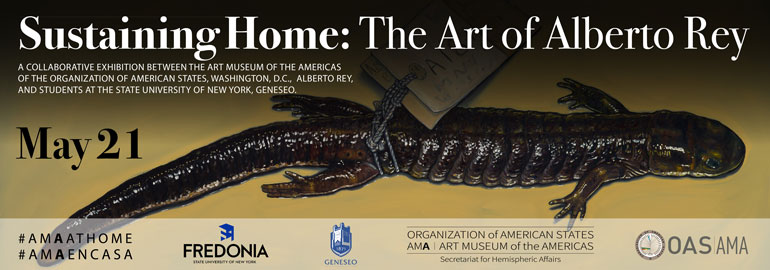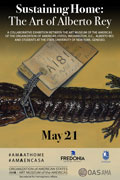
Genevieve Tripoli is a junior at Geneseo and is a Childhood/Special Education major with a concentration in Art History. She says that working on this exhibition has made her realize the diverse ways in which artists showcase their cultural identity, and has been a rewarding experience.
May 27, 2021
Las Balsas 1995-1997
by Genevieve Tripoli
Alberto Rey’s series titled Las Balsas, and Las Balsas Artifacts are intriguing compositions, which convey a story that, for Rey, is cultural and personal, as they are based on the history of Cubans who set out from Cuba on rafts in the hope of finding a safer and better life in the United States. Rey began this series after the summer of 1995, when during a research trip to Cuban Heritage Collection at the University of Miami, he took a side trip to the Key West Library which has an archive of Cuban objects and images. Before reaching Key West, Rey stopped at the Transit Center for Cuban Refugees on Stock Island. There Rey found rafts and objects which had been used by Cubans, as they traveled to the United States in search of a safer life. This project has a personal connection to him because his family suffered the loss of one of his grandmothers during a fatal boat journey from Cuba. The main subject of Rey’s series is the experience of immigration and uncertainty experienced, for decades, by Cuban migrants, who set out on the grueling, 90-mile journey, floating on miniscule rafts and overcrowded boats to Florida, where they would be faced with the fear of whether or not they would be able to stay. Nonetheless, they came.
Alberto Rey’s Las Balsas is a significant series because it forms part of his journey of discovering his own identity, as a Cuban-American, through his art and through subjects meaningful to him and to others who share similar histories. In Rey’s Las Balsas series, he emphasized the physical hardships endured by the balseros (rafters), who set out on the rafts, by including items that have emotional resonance. I found a personal connection to Rey’s work through my desire to educate through art, whether it be in museums or classrooms and to give people of different cultures a way of connecting to the hardships experienced through individuals and groups they might not otherwise have encountered in their daily lives or personal histories.
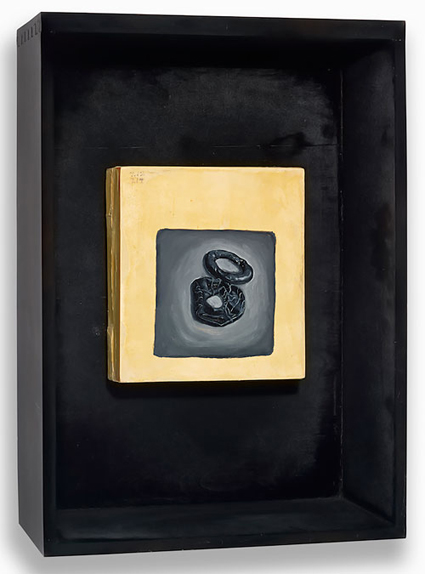
Las Balsas Series: Balsas II, 1995-1999, Painting - 9 x 8 x 2.5”, Oils on Plaster over Wood / Box - 20 x 15 x 6”, Oils on Wood
Alberto Rey’s Las Balsas: II, shares with others in the series a format composed of an image painted on found wood that is placed as part of constructed, dark, wooden box. This arrangement intensifies the spectator’s connection to the actual rafts and to the unknown balseros, who used them, thereby creating a connection for their experience through his work. In Balsas II, the spectator encounters two half-deflated inner tubes, which were once used as rafts, as though they were still floating in the ocean. The raft is depicted in isolation. Rey painted the inner tubes, which are the focus of his composition, in a way that endows them with multiple emotions. The inner tubes appear vulnerable, fragile, overworked, depressed and most noticeably they are starting to crack and deteriorate. A range of complex emotions are embodied in these inanimate objects, which helps the spectator to discover the ways in which Rey himself is uncovering and expressing his own identity and his personal feelings through his artwork. Rey envisioned the suffering and fear that these balseros experienced and the inequity between his life and theirs. His contribution to their history was this documentation of the remains of their unimaginable struggle. Las Balsas is a series wherein Rey painted these vulnerable rafts to portray the weight of cultural experience that he carries, as a Cuban-American, when he thinks about his part of the island’s cultural history. As spectators to Rey’s Balsas II, we can feel the immense weight of these inner tubes along with the terrible sense of uncertainty that comes with their implicit journey and we begin to comprehend a part of Rey’s journey in his search for the answer to the question; Who am I?
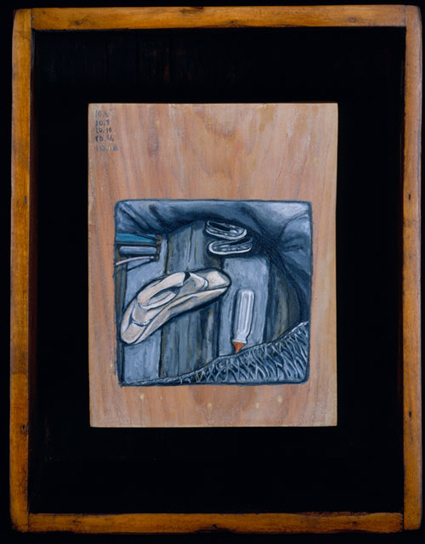
Las Balsas Artifacts: Baby Bottle Childs, Shoes, Air Pump, and Hat, 1995-1999, Oil on Wood, 8 x 10 x 4.5”
Alberto Rey’s Las Balsas Artifacts: Baby Bottle, Child’s Shoes, Air Pump, and Hat invokes the most intense gut wrenching feeling for me of all the works included in this series of portrayals of rafts used by Cubans to cross the ninety mile to reach the United States. In this work, we see the belongings of a family that was once on their journey to a better life. We hope that their journey ended happily but we do not know and, as in the other works found in this series, the uncertainty haunts us. In this work by Rey, we encounter the reality of the presence on the rafts of children and babies as we contemplate their unknown fate, thus this work demonstrates the insecurity that is and always has been part of immigrating to the U.S, which has specific meaning for Rey.
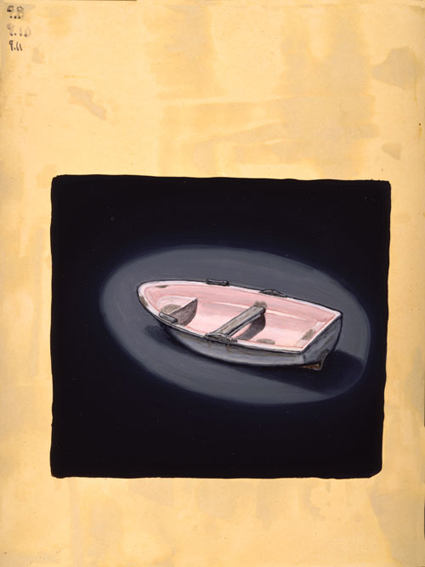
Las Balsas: Rafts: III, 1995-1999, Painting - Oils on Plaster over Wood, 8 x 11 x 2.5” / Box - Oils on Wood, 19.5 x 14 x 11.5”
In Alberto Rey’s Las Balsas: III, we observe a motorboat standing alone with a spotlight effect highlighting its form. Through the use of dark space and the spotlight emphasis, Rey presents this work in a way that draws in the spectator, making it difficult to look away from this raft. The small boat, depicted empty of the belongings and people that once inhabited it, reminds us of the terrible losses people faced during immigration. As an aspiring teacher I believe that we have a responsibility to educate students of all ages about the real-world issues that are occurring all around us and which form our past and impact our present, as they shape our future. As a teacher, I focus my attention on creating a culturally responsive classroom, from the perspective of a white, mainstream American woman, looking to bring together a diverse student group to share universal and specific human experiences. To do this kind of teaching effectively, I bring to my classroom the history, music, literature and art from different cultures so that my students develop a base of communication and understanding. Works of art, such as Rey’s Las Balsas and Las Balsas Artifacts can spark conversations in the classroom. It also brings museums, like the Art Museum of the Americas, into dialogue with intense themes within the topic of immigration. As an experiment in teaching, I asked some of my peers to provide words that described Rey’s artwork, the words I received were - lonely, dark, mysterious, sad, eerie, and nightmarish. The impact of these works recorded how students can be reached through art and I know it is important to use this as a method of teaching.
In his search for his personal identity, Alberto Rey has successfully created two intense series of paintings of Cuban rafts and artifacts that simultaneously explore his identity while capturing the attention of their audience. He allows us to venture into his personal history and emotional connection to this series. Through his work, I feel as though I can better understand the history of Cuban immigration since he depicts such a vulnerable and intriguing, pictorial narrative. As we encounter these paintings, we can commemorate the people who were lost along the way and hopefully we will be inspired to learn from our mistakes, strengthen peace and promote economic, social, and cultural development in the United States and in Latin America. In so doing, we can become part of the mission of the Organization of American States, for which the Art Museum of the Americas is an institution expressive of their goals. Rey’s work can and should also be used to educate people and open up the dialogue about the perils of immigration, which is an ongoing global crisis.

